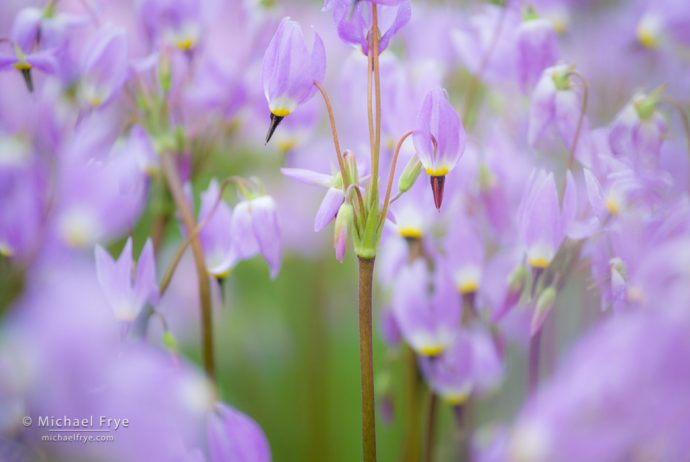
Shooting stars, summer wildflowers, Yosemite. Handheld (a rarity for me) at 1/200th sec., f/4, ISO 400. I’m almost always using medium to small apertures to get everything in focus, but once in awhile it’s fun to use a wide aperture to throw the foreground and background out of focus.
I just finished teaching a workshop, so I’m catching up on posting images from earlier this summer. As I mentioned in a recent post, Claudia and I made several trips in June to the higher elevations of Yosemite to look for wildflowers. We found many shooting stars, which are one of the early bloomers in the high country. They’re beautiful flowers, but they always grow in marshy areas, full of mosquitos. So over the years my brain has made an association between shooting stars and their accompanying insect pests, and just seeing these flowers triggers a psychological reaction that literally makes me itch.
But aside from that initial visceral reaction to the sight of shooting stars, mosquitos don’t generally faze me much. I’ve actually developed a partial immunity to the mosquitos in Yosemite, so bites don’t create welts or make me itch anymore. Mosquitos are still annoying, but a little insect repellent keeps them at bay and lets me concentrate on photographing flowers.
And I always enjoy photographing flowers – even those mosquito-plagued shooting stars – though I sometimes find the compositions challenging. I don’t often do closeups, as I usually prefer incorporating flowers into a wider landscape, or capturing an “intimate” landscape with a mix of flowers, or a pattern, or flowers juxtaposed with trees or rocks.
When compositions don’t immediately present themselves, I let my lens be guided by whatever catches my eye. I trust that if something catches my eye there’s probably a photograph there somewhere. I also try to absorb the feeling of the place, whatever that might be at the moment, and see if something catches my attention that might convey that mood.
And when I can’t find a composition that seems to work, I follow the advice I’ve given many students, which is to get closer, and simplify. Getting in really close to flowers is a last resort for me, because closeups require a great deal of effort and patience – and exceptionally calm winds. But if that’s what will work best to convey the beauty and feeling of the flowers at that moment, then so be it. And it’s great when they work.
Here’s a small portfolio of recent flower photographs, with wide and medium views, and even one closeup. Several of these images were focus-stacked in order to cope with the extreme depth of field. (For more about focus stacking, see this earlier post.)
Since I made these photos the wildflower bloom has continued to progress, and we’ve found some interesting flowers in both mid- and high-elevation meadows. I’ve been capturing whatever catches my eye or seems to convey a feeling at the moment – even closeups. I’ll post some of those images soon.
— Michael Frye
P.S. The Ferguson Fire is not close to our house, so we’re not in any danger. Thanks to all of you who have expressed your concern!
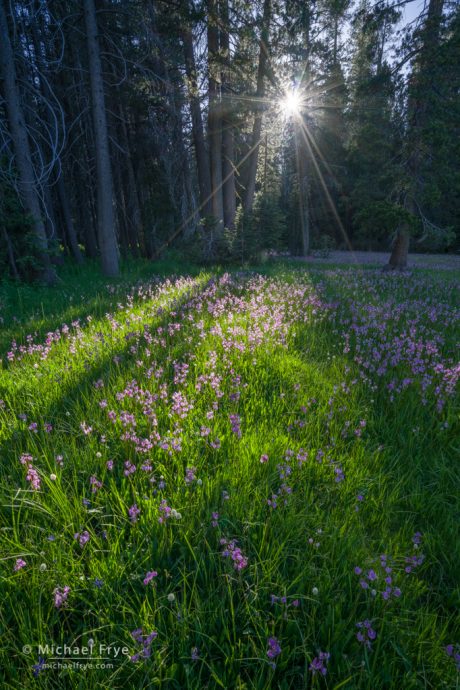
Shooting stars, sun, and lodgepole pines, Yosemite. I loved the stripes of light on the flowers, and decided to go wide to include the sun as well. I used Lightroom’s HDR Merge to blend three exposures, two stops apart.
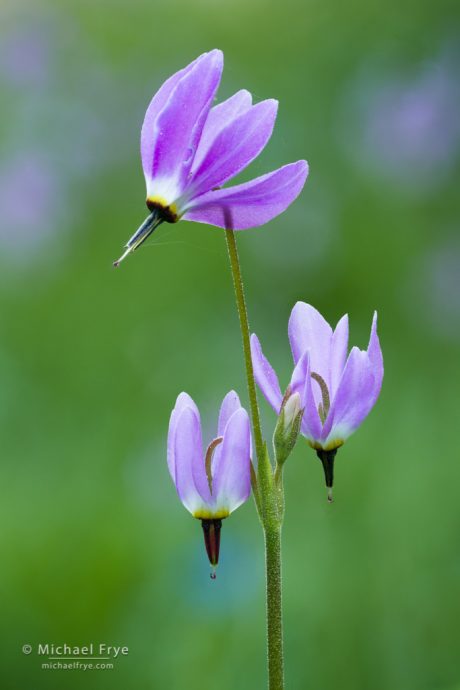
Three shooting stars, Yosemite. With closeup photographs like this it’s difficult to get all of the flower or flowers in focus, yet keep the background soft and out of focus. Here I set the aperture to f/5.6 to make sure the background was blurred, and focus-stacked 12 exposures to get the three flowers and their stems in focus.
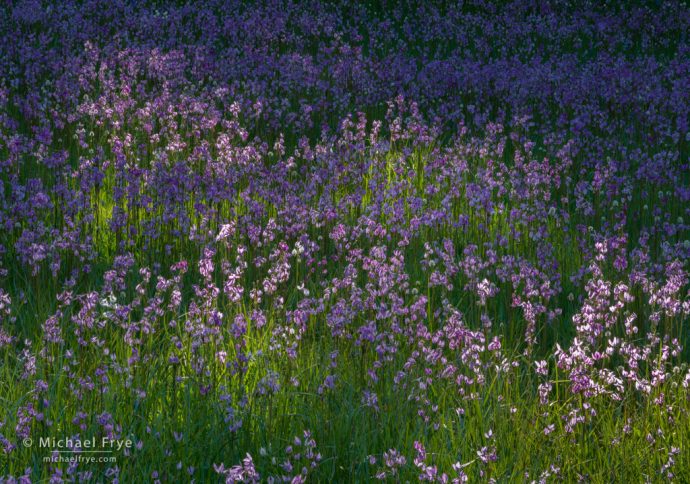
Backlit shooting stars, Yosemite. A fleeting moment of light, but luckily the wind was calm so I was able to focus-stack three exposures (at f/16) to get everything in focus with a long telephoto lens (190mm).
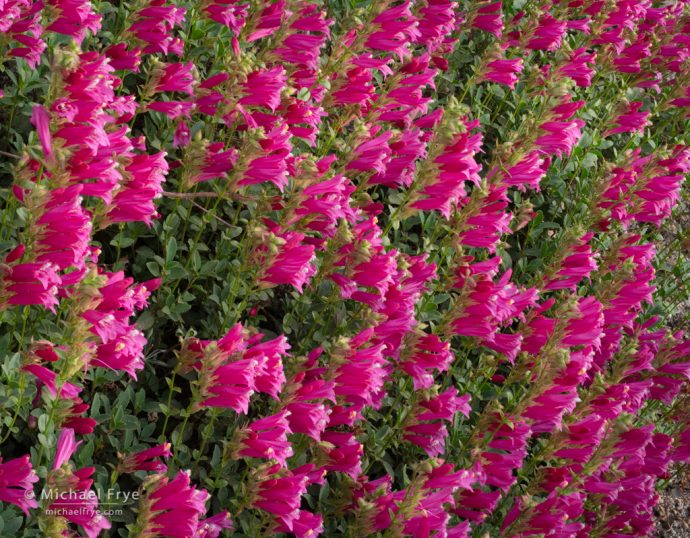
Penstemons, Yosemite. I loved the repeating pattern of these flowers. This was made with a 50mm lens, and again I used focus-stacking to get sufficient depth of field to make everything sharp. This time I blended five exposures, each at f/16.
Related Posts: Owl Encounter; Focus-Stacking Season; Why F/16?
Michael Frye is a professional photographer specializing in landscapes and nature. He is the author or principal photographer of The Photographer’s Guide to Yosemite, Yosemite Meditations, Yosemite Meditations for Women, Yosemite Meditations for Adventurers, and Digital Landscape Photography: In the Footsteps of Ansel Adams and the Great Masters. He has also written three eBooks: Light & Land: Landscapes in the Digital Darkroom, Exposure for Outdoor Photography, and Landscapes in Lightroom: The Essential Step-by-Step Guide. Michael has written numerous magazine articles on the art and technique of photography, and his images have been published in over thirty countries around the world. Michael has lived either in or near Yosemite National Park since 1983, currently residing just outside the park in Mariposa, California.









I always like your flower photos Michael. Thanks for sharing these. Wish I didn’t struggle so much trying to capture them myself. 🙂
Any chance anything blooms around the Tuolumne Meadows area the second week of August when I will be there? Thanks. 🙂
Thanks John. I’m afraid the second week of August is probably too late for most flowers. There might be something blooming way up high above tree line, and perhaps a few late-blooming species along streams or other damp areas.
Thanks, Michael! Such beautiful images, I really like the sun coming through the lodgepole pines onto the shooting stars. Thanks, also, for the update on the fire. As I read about it, I’ve been wondering if it’s close to you—glad to hear you and Claudia are out of danger. I be in the U.S. for a month this August and hope to get a little landscape photography in at Lake Tahoe. Cheers!
Thanks Bob, and I hope you enjoy your trip to Tahoe.
Being from Louisiana you learna few tricks to keep those mosquitoes from biting. If u hate insect replellant like me -give Vaseline baby CREAM oil—NOT BABY OIL— aloe vera /vit E a try. The baby oil is too greasy especially handling camera gear but the creamy version soaks in and keeps most insects from biting —PLUS—u smell really good!
LUV those wildflowers- I was amazed how many slices u combined on macro of shooting star blooms—no wonder my tight macro stacks miss areas—More slices—Do u use a rail to move focal pt???
Thanks for the tip Donna – I’ll have to try that. No, I don’t use a rail. That might be helpful, but as I said, I don’t do closeups that often.
Hi Michael,
Glad you and Claudia are in no danger from the Ferguson fire. Some of the smoke from it has reached us up here at Incline Village.
Love your flower photos especially the shooting stars. Would like to see some more of your close ups.
Carol
All lovely compositions! I really favor the last photo as fuschia is one of my favorite colors. Happy to know you are not in danger of the Ferguson Fire. I’m drowning in all the daily smoke particulates.